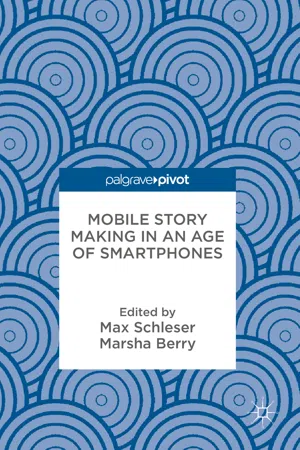This volume outlines how story-making contributes to co-creation , co-design and co-production with “the people formerly known as the audience ” (McGuinness 2016) and explores people’s engagement in the process of production as more than that of pure consumers or passive agents. As media -making has moved from broadcasting channels to digital platforms , the contemporary media environment is characterised by Manovich’s “media mobility ” (2008, p. 203), ephemeral media (Grainge 2011) and what Jenkins labels as “spreadable media ” (Jenkins 2013). The now well-established recognition of audience engagement through participatory culture is a baseline for the discussion of story-making . Digital enterprise has developed content creation strategies that embrace these developments. Here, one could point at Google ’s content creation guidelines (CCC—content framework: Create, Collaborate, Curate—Google Brand Lab); “rather than using video exclusively as a storytelling mechanism, think of it as a tool for story-making , in which consumers get to take part” (Larson 2015). In Mobile AR : Creating Augmented Experiences, David and Schleser (2013) point at the significance of participants in defining the meaning for MR (mixed-reality ) works. This article also cites Danah Boyd’s (Principal Researcher at Microsoft Research and the founder of Data & Society) critique of the term “user” as having drug-user associations. By means on shifting the conversation from the horizontal to a vertical plane of co-producers and co-creators, a conceptual shift takes place . Even in user-centric design and user-based storytelling the dichotomy is maintained. Through modifying the context of “the other” as opposed to the professional or amateur , creator or user, a different model of thinking and engagement is presented. Smartphones as nodes in networked media have illustrated how local networks and visual communication structures are shaped and co-produced.
While our previous volume, Creative Mobile Media in an Age of Smartphones, focused on creative projects as inspiration for debates relating to aesthetics, space and place , knowledge and stories and the self, Creative Mobile Media II explores how smartphones contribute to social change and add further nuances to the definition of creative practices related to smartphone media and screen production. Story-making can contribute towards formulating democratic processes and equity imperatives to create change and challenges traditional models of media production and consumption. This edited collection further investigates how the smartphone has been taken up for story-making and includes research fields such as children’s book design, screenwriting , personal media , Aboriginal knowledge , music sharing , place-making and play , mobile virtual realities, experimental filmmaking , MR experiences , smartphone–spacetime , vertical video and Pasifika youth empowerment .
The chapters in this volume have been arranged according to three themes.
Story-Making
Story-making can lead to self-representation and can engage twenty-first-century citizens who understand the risks of commercial and political discourses anchored within social media . According to the 90-9-1 formula (Arthur 2006; Nielsen 2006), there is a participation inequality on the internet with only 1% of people creating content , 9% editing or modifying that content and 90% viewing content without actively contributing. Mobile Story Making in an Age of Smartphones challenges this formula. The binary opposition of author/audience or producer/user and active/passive cannot move the conversation forward as it is framed in a traditional broadcasting model of thinking, with traditional vertical structures of media production.
In the context of design , Chapter 2 explores mobile media as a development for children’s book design and illustration . In orde...
